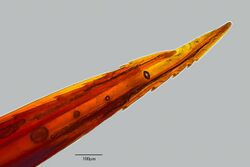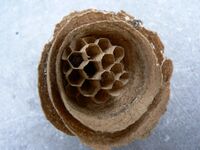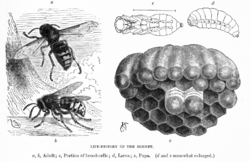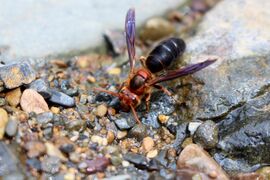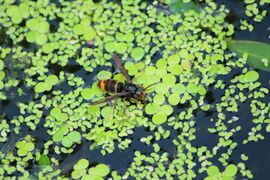Biology:Hornet
| Hornet | |
|---|---|
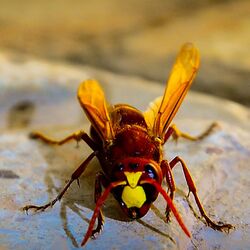
| |
| Oriental hornet (Vespa orientalis) | |
| Scientific classification | |
| Domain: | Eukaryota |
| Kingdom: | Animalia |
| Phylum: | Arthropoda |
| Class: | Insecta |
| Order: | Hymenoptera |
| Family: | Vespidae |
| Subfamily: | Vespinae |
| Genus: | Vespa Linnaeus, 1758 |
| Type species | |
| Vespa crabro Linnaeus, 1758[1]
| |
| Species | |
|
See text | |
Hornets (insects in the genus Vespa) are the largest of the eusocial wasps, and are similar in appearance to their close relatives yellowjackets. Some species can reach up to 5.5 cm (2.2 in) in length. They are distinguished from other vespine wasps by the relatively large top margin of the head. Worldwide, 22 species of Vespa are recognized.[2][3] Most species only occur in the tropics of Asia, though the European hornet (V. crabro) is widely distributed throughout Europe, Russia, North America, and north-eastern Asia. Wasps native to North America in the genus Dolichovespula are commonly referred to as hornets (e.g., baldfaced hornets), but all of them are actually yellowjackets.
Like other social wasps, hornets build communal nests by chewing wood to make a papery pulp. Each nest has one queen, which lays eggs and is attended by workers that, while genetically female, cannot lay fertile eggs. Most species make exposed nests in trees and shrubs, but some (such as Vespa orientalis) build their nests underground or in other cavities. In the tropics, these nests may last year-round, but in temperate areas, the nest dies over the winter, with lone queens hibernating in leaf litter or other insulative material until the spring. Male hornets are docile and do not have huge stingers.
Hornets are often considered pests, as they aggressively guard their nesting sites when threatened and their stings can be more dangerous than those of bees.[4]
Classification
While taxonomically well defined, some confusion may remain about the differences between hornets and other wasps of the family Vespidae, specifically the yellowjackets, which are members of the same subfamily. Also, a related genus of Asian nocturnal vespines, Provespa, is referred to as "night wasps" or "night hornets",[5] though they are not true hornets.[6]
Some other large wasps are sometimes referred to as hornets, most notably the bald-faced hornet (Dolichovespula maculata) found in North America. It is set apart by its black and ivory coloration. The name "hornet" is used for this species primarily because of its habit of making aerial nests (similar to some of the true hornets) rather than subterranean nests. Another example is the Australian hornet (Abispa ephippium), which is actually a species of potter wasp.
Distribution
Hornets are found mainly in the Northern Hemisphere. The European hornet (V. crabro) is the best-known species, widely distributed in Europe (but is never found north of the 63rd parallel), and European Russia (except in extreme northern areas). In the east, the species' distribution area stretches over the Ural Mountains to western Siberia (found in the vicinity of Khanty-Mansiysk). In Asia, the European hornet is found in southern Siberia, as well as in eastern China. The European hornet was accidentally introduced to eastern North America about the middle of the 19th century and has lived there since at about the same latitudes as in Europe. However, it has never been found in western North America.
The Asian giant hornet (V. mandarinia) lives in the Primorsky Krai, Khabarovsky Krai (southern part), and Jewish Autonomous Oblast regions of Russia, and China , Korea, Taiwan, Cambodia, Laos, Vietnam, Indochina, India , Nepal, Sri Lanka, and Thailand, but is most commonly found in the mountains of Japan , where they are commonly known as the giant sparrow bee.
The Oriental hornet (V. orientalis) occurs in semidry, subtropical areas of central Asia (Azerbaijan, Armenia, Dagestan in Russia, Iran, Afghanistan, Oman, Pakistan , Bangladesh, Turkmenistan, Uzbekistan, Tajikistan, Kyrghyzstan, southern Kazakhstan), and southern Europe (Italy, Malta, Albania, Romania, Turkey, Greece, Bulgaria, Cyprus).[7]
The Asian hornet (V. velutina) has been introduced to France , Spain , Portugal, Italy, and the United Kingdom .
Stings
Hornets have stingers used to kill prey and defend nests. Hornet stings are more painful to humans than typical wasp stings because hornet venom contains a large amount (5%) of acetylcholine.[8][9] Individual hornets can sting repeatedly. Unlike honey bees, hornets do not die after stinging because their stingers are very finely barbed (only visible under high magnification) and can easily be withdrawn, so are not pulled out of their bodies when disengaging.
The toxicity of hornet stings varies according to hornet species; some deliver just a typical insect sting, while others are among the most venomous known insects.[10] Single hornet stings are not in themselves fatal, except sometimes to allergic victims.[10] Multiple stings by hornets (other than V. crabro) may be fatal because of highly toxic species-specific components of their venom.[11]
The stings of the Asian giant hornet (V. mandarinia) are among the most venomous known,[10] and are thought to cause 30–50 human deaths annually in Japan. Between July and September 2013, hornet stings caused the death of 42 people in China.[12] Asian giant hornet's venom can cause allergic reactions and multiple organ failure leading to death, though dialysis can be used to remove the toxins from the bloodstream. As with other wasps, death due to a single sting on the skin only occurs when an allergy is present, and serious outcomes with Asian giant hornet stings in China and Japan are only documented with many stings or anaphylactic shock due to an existing allergy.[12]
People who are allergic to wasp venom may also be allergic to hornet stings. Allergic reactions are commonly treated with epinephrine (adrenaline) injection using a device such as an epinephrine autoinjector, with prompt follow-up treatment in a hospital. In severe cases, allergic individuals may go into anaphylactic shock and die unless treated promptly.[13] In general, Vespa stings induce the release of histamine due to the various mastoparans that they contain.[Herrera et al 2020 1] However V. orientalis mastoparan is the interesting exception because it does not induce histamine increase in victim tissue[Jalaei et al 2016 1] – because it does not cause mast cell degranulation[Jalaei et al 2016 2] – and is not immunogenic.[Jalaei et al 2016 3]
Attack pheromone
Hornets, like many social wasps, can mobilize the entire nest to sting in defense, which is highly dangerous to humans and other animals. The attack pheromone is released in case of threat to the nest. In the case of the Asian giant hornet (V. mandarinia), this is also used to mobilize many workers at once when attacking colonies of their prey, honey bees and other Vespa species.[14] Three biologically active chemicals, 2-Pentanol, Isoamyl alcohol, and 1-methylbutyl 3-methylbutanoate, have been identified for this species. In field tests, 2-Pentanol alone triggered mild alarm and defensive behavior, but adding the other two compounds increased aggressiveness in a synergistic effect.[14] In the European hornet (V. crabro) the major compound of the alarm pheromone is 2-methyl-3-butene-2-ol.[15]
If a hornet is killed near a nest, it may release pheromones that can cause the other hornets to attack. Materials that come into contact with these pheromones, such as clothes, skin, and dead prey or hornets, can also trigger an attack, as can certain food flavorings, such as banana and apple flavorings, and fragrances that contain C5 alcohols and C10 esters.[14]
Life cycle
In V. crabro, the nest is founded in spring by a fertilized female known as the queen. She generally selects sheltered places such as dark, hollow tree trunks. She first builds a series of cells (up to 50) out of chewed tree bark. The cells are arranged in horizontal layers named combs, each cell being vertical and closed at the top. An egg is then laid in each cell. After 5–8 days, the egg hatches. Over the following two weeks, the larva progresses through five stages of development. During this time, the queen feeds it a protein-rich diet of insects. Then, the larva spins a silk cap over the cell's opening, and during the next two weeks, transforms into an adult, a process called metamorphosis. The adult then eats its way through the silk cap. This first generation of workers, invariably females, now gradually undertakes all the tasks formerly carried out by the queen (foraging, nest building, taking care of the brood, etc.) with the exception of egg-laying, which remains exclusive to the queen.
As the colony size grows, new combs are added, and an envelope is built around the cell layers until the nest is entirely covered, with the exception of an entry hole. To be able to build cells in total darkness, they apparently use gravity to aid them.[clarification needed][citation needed] At the peak of its population, which occurs in late summer, the colony can reach a size of 700 workers.
At this time, the queen starts producing the first reproductive individuals. Fertilized eggs develop into females (called "gynes" by entomologists), and unfertilized ones develop into males (sometimes called "drones" as with honeybee drones). Adult males do not participate in nest maintenance, foraging, or caretaking of the larvae. In early to mid-autumn, they leave the nest and mate during "nuptial flights".
Other temperate species (e.g., the yellow hornet, V. simillima, or the Oriental hornet, V. orientalis) have similar cycles. In the case of tropical species (e.g., V. tropica), life histories may well differ, and in species with both tropical and temperate distributions (such as the Asian giant hornet, V. mandarinia), the cycle likely depends on latitude.
Diet and feeding
Adult hornets and their relatives (e.g., yellowjackets) feed themselves with nectar and sugar-rich plant foods. Thus, they can often be found feeding on the sap of oak trees, rotting sweet fruits, honey, and any sugar-containing foodstuffs. Hornets frequently fly into orchards to feed on overripe fruit, and tend to gnaw a hole in fruit to become totally immersed in its pulp. A person who accidentally picks fruit with a feeding hornet can be attacked by the disturbed insect.
The adults also attack various insects, which they kill with stings and jaws. Due to their size and the power of their venom, hornets are able to kill large insects such as honey bees, grasshoppers, locusts, and katydids without difficulty. The victim is fully masticated and then fed to the larvae developing in the nest, rather than consumed by the adult hornets.[citation needed] Given that some of their prey are considered pests, hornets may be considered beneficial under some circumstances.
The larvae of hornets produce a sweet secretion containing sugars and amino acids that is consumed by the workers and queens.[16]
Predatory strategies
Hornets' ability to prey upon honey bees is favored by a number of adaptations. Vespa have a larger body size compared to their prey, a heavy exoskeleton to resist bee attacks, and strong mandibles and venomous sting. As concerns hornet hunting strategies, it has been demonstrated that some species such as V. tropica and V. velutina, can use both visual and olfactory cues for the long-range detection of honey bee colonies. Foragers of V. tropica can readily associate color and shape with potential food sources and exhibit color generalization. V. velutina foragers visually distinguish between bee dummy bait and cotton ball dummy bait, both treated with bee odors, preferring bee dummies. Foraging hornets are also selectively attracted to honey bee colony odors, in particular honey and pollen, as well as honey bee pheromones, which may signal a high prey density. In laboratory assays, workers of V. velutina oriented especially towards geraniol, a component of the honey bee worker aggregation pheromone, that could therefore represent an honest signal for hornets. Behavioral, chemical and electrophysiological analyses have also demonstrated that Vespa bicolor is attracted to (Z)-11-eicosen-1-ol, which is major compound in the alarm pheromones of both Asian (Apis cerana) and European (Apis mellifera) honey bees, and its antennae respond to this compound. Intriguingly, this hornet attraction to honey bee pheromone is also exploited by the orchid Dendrobium christyanum, which mimics the honey bee alarm pheromone in its flowers' scent to attract hornets that visit and pollinate the flowers. It is therefore likely that bee-hunting hornets visit the non-rewarding flowers in search of prey.[17]
Species
While a history of recognizing subspecies exists within many of the Vespa species, the most recent taxonomic revision of the genus treats all subspecific names in the genus Vespa as synonyms, effectively relegating them to no more than informal names for regional color forms.[3]
- Vespa affinis
- Vespa analis
- Vespa basalis
- Vespa bellicosa
- Vespa bicolor
- †Vespa bilineata
- Vespa binghami
- †Vespa ciliata
- †Vespa cordifera
- Vespa crabro
- †Vespa crabroniformis
- †Vespa dasypodia
- Vespa ducalis
- Vespa dybowskii
- Vespa fervida
- Vespa fumida
- Vespa luctuosa
- Vespa mandarinia
- Vespa mocsaryana
- Vespa multimaculata
- †Vespa nigra
- Vespa orientalis
- Vespa philippinensis
- †Vespa picea
- Vespa simillima
- Vespa soror
- Vespa tropica
- Vespa velutina
- Vespa vivax
Notable species
- Asian giant hornet (V. mandarinia) (one of its color forms is also known as the Japanese giant hornet)
- Asian hornet (V. velutina) (also known as the yellow-legged hornet or Asian predatory wasp)
- Black hornet (V. dybowskii)
- Black-bellied hornet (V. basalis)
- Black shield wasp (V. bicolor)
- European hornet (V. crabro) (also known as the Old World hornet or brown hornet)
- Greater banded hornet (V. tropica)
- Lesser banded hornet (V. affinis)
- Oriental hornet (V. orientalis)
- Yellow hornet (V. simillima) (one of its color forms is also known as the Japanese yellow hornet or Japanese hornet)
- Vespa luctuosa (a species which has the most lethal wasp venom per volume)[10]
As food and medicine
Hornet larvae are widely accepted as food in mountainous regions in China. Hornets and their nests are treated as medicine in traditional Chinese medicine.[18][19][20]
Gallery
Black-bellied hornet (Vespa basalis), Xingping
Asian hornet (Vespa velutina), Shanghai
See also
- Australian hornet
- Bald-faced hornet
- Yellowjacket
- Characteristics of common wasps and bees
References
- ↑ James M. Carpenter; Jun-ichi Kojima (1997). "Checklist of the species in the subfamily Vespinae (Insecta: Hymenoptera: Vespidae)". Natural History Bulletin of Ibaraki University 1: 51–92. http://research.amnh.org/iz/f/Carpenter_Kojima_1997_ves.pdf.
- ↑ Archer, M.E. (2012). Penney, D.. ed. Vespine wasps of the world: behaviour, ecology and taxonomy of the Vespinae. Monograph Series. 4. Siri Scientific. ISBN 9780956779571. OCLC 827754341.
- ↑ 3.0 3.1 A.H. Smith-Pardo, J.M. Carpenter, L. Kimsey (2020) The diversity of hornets in the genus Vespa (Hymenoptera: Vespidae; Vespinae), their importance and interceptions in the United States. Insect Systematics and Diversity 4(3) https://doi.org/10.1093/isd/ixaa006
- ↑ Vetter, Richard S.; Visscher, P. Kirk; Camazine, Scott (1999). "Mass Envenomations by Honey Bees and Wasps". Western Journal of Medicine 170 (4): 223–227. PMID 10344177.
- ↑ "Untitled Document". http://www.vespa-bicolor.net/main/vespid/provespa.htm.
- ↑ Madl, M (2012). "Notes on the genus Provespa Ashmead, 1903 (Insecta: Hymenoptera: Vespidae: Vespinae) based on the material of the Naturhistorisches Museum Wien (Austria)". Annals Naturhistorisches Museum Wien 114: 27–35. http://www.zobodat.at/pdf/ANNA_114B_0027-0035.pdf. Retrieved 10 March 2016.
- ↑ Dieter Kosmeier. "Vespa orientalis, Oriental Hornet". vespa-crabro.de. http://www.vespa-crabro.de/oriental-hornet.htm.
- ↑ K. D. Bhoola; J. D. Calle; M. Schachter (1961). "Identification of acetylcholine, 5-hydroxytryptamine, histamine, and a new kinin in hornet venom (V. crabro)". J. Physiol. 159 (1): 167–182. doi:10.1113/jphysiol.1961.sp006799. PMID 13868844.
- ↑ Conniff, R. (June 2003). "Stung – How tiny little insects get us to do exactly as they wish". Discover. http://discovermagazine.com/2003/jun/featstung/.
- ↑ 10.0 10.1 10.2 10.3 J.O. Schmidt; S. Yamane; M. Matsuura; C.K. Starr (1986). "Hornet venoms: lethalities and lethal capacities.". Toxicon 24 (9): 950–4. doi:10.1016/0041-0101(86)90096-6. PMID 3810666.
- ↑ P. Barss (1989). "Renal failure and death after multiple stings in Papua New Guinea. Ecology, prevention and management of attacks by vespid wasps". Med J Aust 151 (11–12): 659–63. doi:10.5694/j.1326-5377.1989.tb139643.x. PMID 2593913.
- ↑ 12.0 12.1 Park, Madison; Zhang, Dayu; Landau, Elizabeth (October 3, 2013). "Deadly giant hornets kill 42 people in China". CNN. http://edition.cnn.com/2013/10/03/world/asia/hornet-attack-china/index.html.
- ↑ "Insect bites and stings: MedlinePlus Medical Encyclopedia". https://www.nlm.nih.gov/medlineplus/ency/article/000033.htm.
- ↑ 14.0 14.1 14.2 "Volatile fragrance chemicals may attract unwanted attention from hornets and bees". http://pubs.acs.org/cen/critter/8137hornets.html.
- ↑ "Vespa". pherobase.com. http://www.pherobase.com/database/genus/genus-Vespa.php.
- ↑ Wheeler, W.M. (1922) Social Life Among the Insects. II. The Scientific Monthly 15(1): 68–88
- ↑ Cappa, Federico; Cini, Alessandro; Bortolotti, Laura; Poidatz, Juliette; Cervo, Rita (November 2021). "Hornets and honey bees: A coevolutionary arms race between ancient adaptations and new invasive threats". Insects 12 (11): 1037. doi:10.3390/insects12111037. PMID 34821837.
 This article incorporates text available under the CC BY 4.0 license.
This article incorporates text available under the CC BY 4.0 license.
- ↑ Eric Gershwin, M.; Bruce German, J.; Keen, Carl L. (1999-11-12). Nutrition and Immunology: Principles and Practice. Springer. ISBN 9781592597093. https://books.google.com/books?id=hf8ICAAAQBAJ&dq=Hornets+nest+chinese+medicine&pg=PA444. Retrieved 2022-08-30.
- ↑ Wiseman, Nigel (21 July 2022). Chinese-English Dictionary of Chinese Medical Terms. Paradigm Publications. ISBN 9780912111674. https://books.google.com/books?id=ROJ8EAAAQBAJ&dq=Hornets+nest+chinese+medicine&pg=PT336. Retrieved 2022-08-30.
- ↑ Lu Feng Fang, Materia Metrica
- Jalaei, Jafar; Fazeli, Mehdi; Rajaian, Hamid; Ghalehsoukhteh, Somayeh Layeghi; Dehghani, Alireza; Winter, Dominic (2016). "In vitro antihistamine-releasing activity of a peptide derived from wasp venom of Vespa orientalis". Asian Pacific Journal of Tropical Biomedicine (Medknow) 6 (3): 259–264. doi:10.1016/j.apjtb.2015.12.001. ISSN 2221-1691.
- ↑ p. 263, "Cytotoxicity data from a LDH release assay, which measure damage to the plasma membrane showed no significant increase in percentage of LDH release and its IC50 was nearly 128 μL, so we confirmed that LDH absorbance was not affected by this peptide."
- ↑ p. 262, "Moreover, the results showed the IC50 of mast cells degranulation at 126 μmol/L, which was approximately high implying that this peptide had high selectivity for normal cells"
- ↑ p. 262, "implying that this peptide had [...] immuno-modulation property which led the prevention of immune system activation (Figure 7)."
- Herrera, Cayetano; Leza, Mar; Martínez-López, Emma (2020-07-23). "Diversity of compounds in Vespa spp. venom and the epidemiology of its sting: a global appraisal". Archives of Toxicology (Springer Science and Business Media LLC) 94 (11): 3609–3627. doi:10.1007/s00204-020-02859-3. ISSN 0340-5761. PMID 32700166.
- ↑ p. 3, "Several studies have shown that mastoparans act on mast cells. [...] They are responsible for releasing, mainly, histamine ..."
External links
- European hornet protection site (in English) (also available in French, German, Russian, Spanish and Swedish)
- Paper Wasps and Hornets
- Controlling Wasps, Hornets, and Yellowjackets
- Hornets & Yellowjackets
- Yellowjackets and Other Social Wasps
- Vespidae of the World
- yellowjackets and hornets of Florida on the UF / IFAS Featured Creatures Web site
- "Invasive Hornets project" (in en). UGA, Invasive.Org, USDA, USDA NIFA, Southern IPM Center, Southern Plant Diagnostic Center (NPDN), PPQ ITP. http://www.ipmimages.org/browse/projectthumb.cfm?proj=1159.
Wikidata ☰ Q334422 entry
 |

